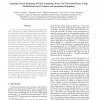Free Online Productivity Tools
i2Speak
i2Symbol
i2OCR
iTex2Img
iWeb2Print
iWeb2Shot
i2Type
iPdf2Split
iPdf2Merge
i2Bopomofo
i2Arabic
i2Style
i2Image
i2PDF
iLatex2Rtf
Sci2ools
CVPR
2008
IEEE
2008
IEEE
Semantic-based indexing of fetal anatomies from 3-D ultrasound data using global/semi-local context and sequential sampling
The use of 3-D ultrasound data has several advantages over 2-D ultrasound for fetal biometric measurements, such as considerable decrease in the examination time, possibility of post-exam data processing by experts and the ability to produce 2-D views of the fetal anatomies in orientations that cannot be seen in common 2-D ultrasound exams. However, the search for standardized planes and the precise localization of fetal anatomies in ultrasound volumes are hard and time consuming processes even for expert physicians and sonographers. The relative low resolution in ultrasound volumes, small size of fetus anatomies and intervolume position, orientation and size variability make this localization problem even more challenging. In order to make the plane search and fetal anatomy localization problems completely automatic, we introduce a novel principled probabilistic model that combines discriminative and generative classifiers with contextual information and sequential sampling. We imple...
2-d Ultrasound Exams | Computer Vision | CVPR 2008 | Fetal Anatomies | Fetal Anatomy Localization | Fetal Biometric Measurements | Fetus Anatomies |
| Added | 12 Oct 2009 |
| Updated | 12 Oct 2009 |
| Type | Conference |
| Year | 2008 |
| Where | CVPR |
| Authors | Gustavo Carneiro, Fernando Amat, Bogdan Georgescu, Sara Good, Dorin Comaniciu |
Comments (0)

